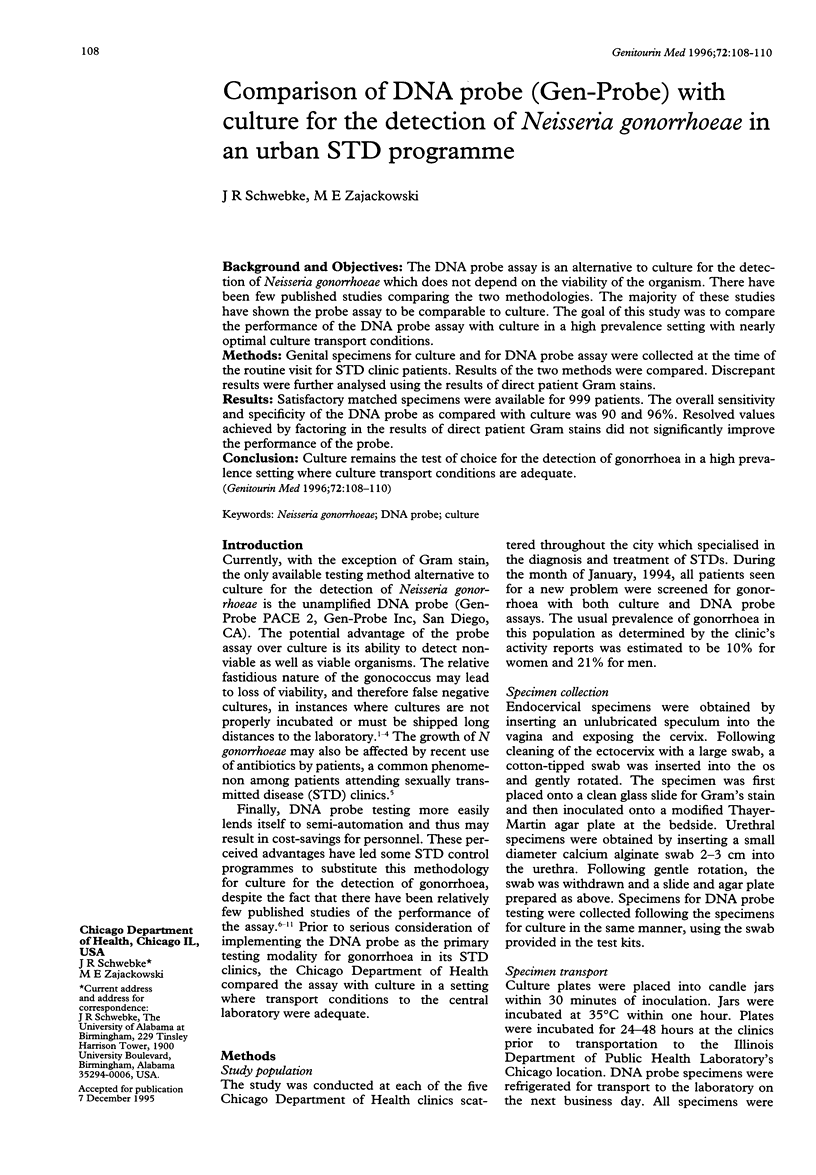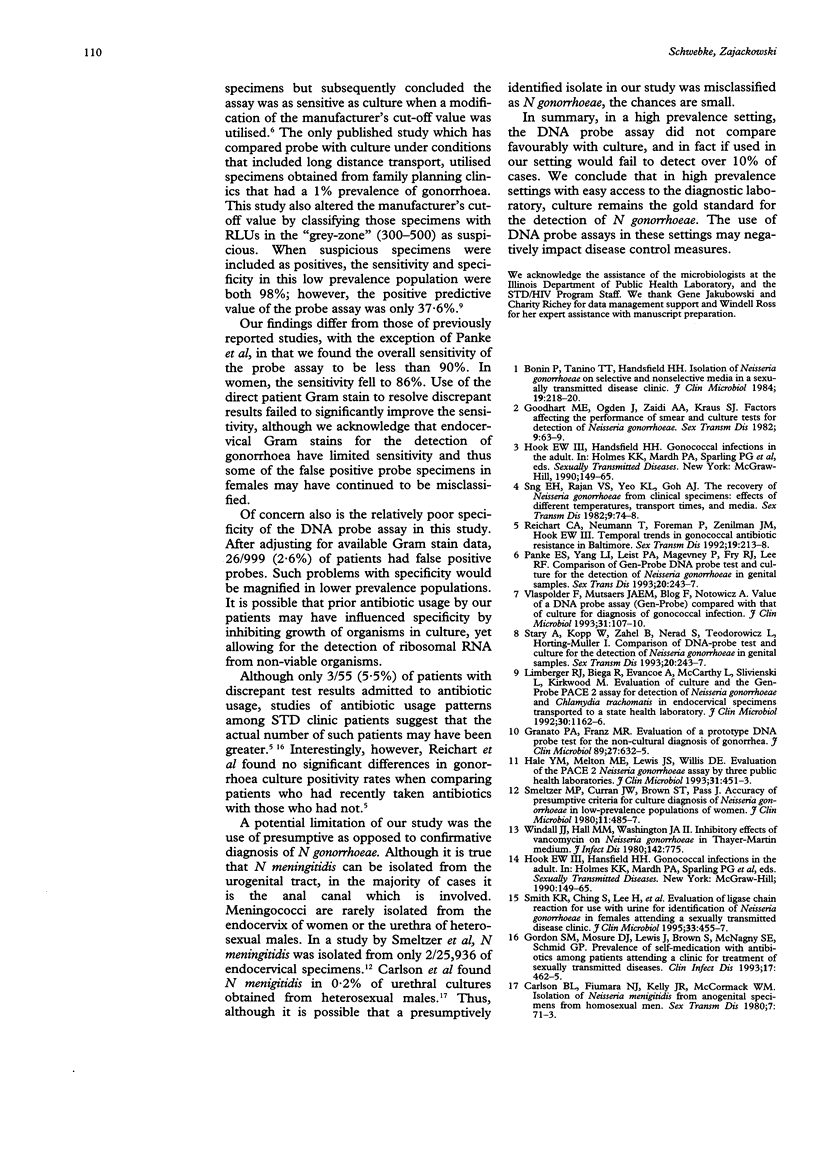Abstract
BACKGROUND AND OBJECTIVES: The DNA probe assay is an alternative to culture for the detection of Neisseria gonorrhoeae which does not depend on the viability of the organism. There have been few published studies comparing the two methodologies. The majority of these studies have shown the probe assay to be comparable to culture. The goal of this study was to compare the performance of the DNA probe assay with culture in a high prevalence setting with nearly optimal culture transport conditions. METHODS: Genital specimens for culture and for DNA probe assay were collected at the time of the routine visit for STD clinic patients. Results of the two methods were compared. Discrepant results were further analysed using the results of direct patient Gram stains. RESULTS: Satisfactory matched specimens were available for 999 patients. The overall sensitivity and specificity of the DNA probe as compared with culture was 90 and 96%. Resolved values achieved by factoring in the results of direct patient Gram stains did not significantly improve the performance of the probe. CONCLUSION: Culture remains the test of choice for the detection of gonorrhoea in a high prevalence setting where culture transport conditions are adequate.
Full text
PDF


Selected References
These references are in PubMed. This may not be the complete list of references from this article.
- Bonin P., Tanino T. T., Handsfield H. H. Isolation of Neisseria gonorrhoeae on selective and nonselective media in a sexually transmitted disease clinic. J Clin Microbiol. 1984 Feb;19(2):218–220. doi: 10.1128/jcm.19.2.218-220.1984. [DOI] [PMC free article] [PubMed] [Google Scholar]
- Carlson B. L., Fiumara N. J., Kelly J. R., McCormack W. M. Isolation of Neisseria meningitidis from anogenital specimens from homosexual men. Sex Transm Dis. 1980 Apr-Jun;7(2):71–73. doi: 10.1097/00007435-198004000-00008. [DOI] [PubMed] [Google Scholar]
- Goodhart M. E., Ogden J., Zaidi A. A., Kraus S. J. Factors affecting the performance of smear and culture tests for the detection of Neisseria gonorrhoeae. Sex Transm Dis. 1982 Apr-Jun;9(2):63–69. doi: 10.1097/00007435-198204000-00002. [DOI] [PubMed] [Google Scholar]
- Gordon S. M., Mosure D. J., Lewis J., Brown S., McNagny S. E., Schmid G. P. Prevalence of self-medication with antibiotics among patients attending a clinic for treatment of sexually transmitted diseases. Clin Infect Dis. 1993 Sep;17(3):462–465. doi: 10.1093/clinids/17.3.462. [DOI] [PubMed] [Google Scholar]
- Hale Y. M., Melton M. E., Lewis J. S., Willis D. E. Evaluation of the PACE 2 Neisseria gonorrhoeae assay by three public health laboratories. J Clin Microbiol. 1993 Feb;31(2):451–453. doi: 10.1128/jcm.31.2.451-453.1993. [DOI] [PMC free article] [PubMed] [Google Scholar]
- Limberger R. J., Biega R., Evancoe A., McCarthy L., Slivienski L., Kirkwood M. Evaluation of culture and the Gen-Probe PACE 2 assay for detection of Neisseria gonorrhoeae and Chlamydia trachomatis in endocervical specimens transported to a state health laboratory. J Clin Microbiol. 1992 May;30(5):1162–1166. doi: 10.1128/jcm.30.5.1162-1166.1992. [DOI] [PMC free article] [PubMed] [Google Scholar]
- Reichart C. A., Neumann T., Foreman P., Zenilman J. M., Hook E. W., 3rd Temporal trends in gonococcal antibiotic resistance in Baltimore. Sex Transm Dis. 1992 Jul-Aug;19(4):213–218. doi: 10.1097/00007435-199207000-00006. [DOI] [PubMed] [Google Scholar]
- Smeltzer M. P., Curran J. W., Brown S. T., Pass J. Accuracy of presumptive criteria for culture diagnosis of Neisseria gonorrhoeae in low-prevalence populations of women. J Clin Microbiol. 1980 May;11(5):485–487. doi: 10.1128/jcm.11.5.485-487.1980. [DOI] [PMC free article] [PubMed] [Google Scholar]
- Smith K. R., Ching S., Lee H., Ohhashi Y., Hu H. Y., Fisher H. C., 3rd, Hook E. W., 3rd Evaluation of ligase chain reaction for use with urine for identification of Neisseria gonorrhoeae in females attending a sexually transmitted disease clinic. J Clin Microbiol. 1995 Feb;33(2):455–457. doi: 10.1128/jcm.33.2.455-457.1995. [DOI] [PMC free article] [PubMed] [Google Scholar]
- Sng E. H., Rajan V. S., Yeo K. L., Goh A. J. The recovery of Neisseria gonorrhoeae from clinical specimens: effects of different temperatures, transport times, and media. Sex Transm Dis. 1982 Apr-Jun;9(2):74–78. doi: 10.1097/00007435-198204000-00004. [DOI] [PubMed] [Google Scholar]
- Stary A., Kopp W., Zahel B., Nerad S., Teodorowicz L., Hörting-Müller I. Comparison of DNA-probe test and culture for the detection of Neisseria gonorrhoeae in genital samples. Sex Transm Dis. 1993 Sep-Oct;20(5):243–247. doi: 10.1097/00007435-199309000-00001. [DOI] [PubMed] [Google Scholar]
- Vlaspolder F., Mutsaers J. A., Blog F., Notowicz A. Value of a DNA probe assay (Gen-Probe) compared with that of culture for diagnosis of gonococcal infection. J Clin Microbiol. 1993 Jan;31(1):107–110. doi: 10.1128/jcm.31.1.107-110.1993. [DOI] [PMC free article] [PubMed] [Google Scholar]
- Windall J. J., Hall M. M., Washington J. A., 2nd, Douglass T. J., Weed L. A. Inhibitory effects of vancomycin on Neisseria gonorrhoeae in Thayer-Martin medium. J Infect Dis. 1980 Nov;142(5):775–775. doi: 10.1093/infdis/142.5.775. [DOI] [PubMed] [Google Scholar]


